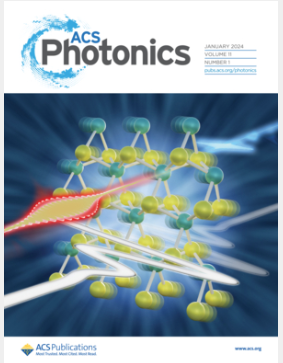单金纳米板/二硫化钼异质结构中等离子体增强光电流的映射
IF 6.7
1区 物理与天体物理
Q1 MATERIALS SCIENCE, MULTIDISCIPLINARY
引用次数: 0
摘要
二维二硫化钼是一种很有前途的材料,可用于能量转换或光收集,但单层二硫化钼的弱光吸收阻碍了其在器件中的直接应用。为了增强MoS2的吸收,基于金属半导体异质结构的各种策略已经开发出来,其中多种工艺可以有效,取决于微妙的局部纳米尺度参数。揭示这些过程中的关键因素需要在微观甚至纳米尺度上对单一异质结构进行表征。我们在光电化学电池内对单个金纳米板/二硫化钼异质结构进行了直接光电流映射(PCM),在纳米板边缘显示了强烈的光电流信号。与MoS2/Au纳米板/TiO2异质结构相比,Au纳米板/MoS2/TiO2异质结构表现出更好的性能,在600 nm激发波长下实现了32.8 nA的最大光电流性能,这是异质结构的32倍。我们的PCM测量表明,在不同的激发波长下,不同的激发功率可以实现最大的性能,并且从长激发波长下的线性功率依赖转变为短激发波长下的超线性依赖。通过对电子场和等离子体热效应的理论分析,揭示了在不同激发波长和功率下的不同增强因子,与实验结果一致。我们得出结论,MoS2层的性能是由等离子体共振能量转移增强的,在较长的波长范围内具有强的树脂共振耦合,而在较短的波长(<600 nm)由Au带间跃迁引起的热效应促进。本文章由计算机程序翻译,如有差异,请以英文原文为准。

Mapping Plasmon-Enhanced Photocurrent in Single Au Nanoplate/MoS2 Heterostructures
Two-dimensional MoS2 is a promising material for applications in energy conversion or light harvesting, but the weak light absorption by monolayer MoS2 hinders its direct application in devices. To enhance the absorption of MoS2, various strategies have been developed based on metal–semiconductor heterostructures, where multiple processes can be effective, depending on subtle local nanoscale parameters. Revealing key factors in such processes requires characterization on single heterostructures, at the micro- or even nanoscale. We present direct photocurrent mapping (PCM) on single Au nanoplate/MoS2 heterostructures inside a photoelectrochemical cell, which reveals intense photocurrent signal at the nanoplate edges. The Au nanoplate/MoS2/TiO2 heterostructure exhibits a better performance in comparison to MoS2/Au nanoplate/TiO2 structure, achieving maximum photocurrent performance of 32.8 nA under 600 nm excitation wavelength, which represents an enhancement factor of 32× due to the heterostructure. Our PCM measurements indicate that maximum performance is achieved at different excitation wavelengths for varying excitation power, with a transition from a linear power dependence at long excitation wavelengths to superlinear dependence at short excitation wavelengths. A thorough theoretical analysis including both E-field and plasmonic thermal effects revealed different enhancement factors at different excitation wavelengths and powers, in agreement with the experiment. We conclude that the performance of the MoS2 layer is enhanced by plasmon resonance energy transfer in the spectral range with strong plexcitionic resonance coupling, at longer wavelengths, whereas it is promoted by a thermal effect due to Au interband transitions at shorter wavelengths (<600 nm).
求助全文
通过发布文献求助,成功后即可免费获取论文全文。
去求助
来源期刊

ACS Photonics
NANOSCIENCE & NANOTECHNOLOGY-MATERIALS SCIENCE, MULTIDISCIPLINARY
CiteScore
11.90
自引率
5.70%
发文量
438
审稿时长
2.3 months
期刊介绍:
Published as soon as accepted and summarized in monthly issues, ACS Photonics will publish Research Articles, Letters, Perspectives, and Reviews, to encompass the full scope of published research in this field.
 求助内容:
求助内容: 应助结果提醒方式:
应助结果提醒方式:


